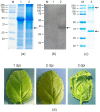Plant-Produced Nanoparticles Based on Artificial Self-Assembling Peptide Bearing the Influenza M2e Epitope
- PMID: 37299207
- PMCID: PMC10255905
- DOI: 10.3390/plants12112228
Plant-Produced Nanoparticles Based on Artificial Self-Assembling Peptide Bearing the Influenza M2e Epitope
Abstract
Despite advances in vaccine development, influenza remains a persistent global health threat and the search for a broad-spectrum recombinant vaccine against influenza continues. The extracellular domain of the transmembrane protein M2 (M2e) of the influenza A virus is highly conserved and can be used to develop a universal vaccine. M2e is a poor immunogen by itself, but it becomes highly immunogenic when linked to an appropriate carrier. Here, we report the transient expression of a recombinant protein comprising four tandem copies of M2e fused to an artificial self-assembling peptide (SAP) in plants. The hybrid protein was efficiently expressed in Nicotiana benthamiana using the self-replicating potato virus X-based vector pEff. The protein was purified using metal affinity chromatography under denaturing conditions. The hybrid protein was capable of self-assembly in vitro into spherical particles 15-30 nm in size. The subcutaneous immunization of mice with M2e-carrying nanoparticles induced high levels of M2e-specific IgG antibodies in serum and mucosal secretions. Immunization provided mice with protection against a lethal influenza A virus challenge. SAP-based nanoparticles displaying M2e peptides can be further used to develop a recombinant "universal" vaccine against influenza A produced in plants.
Keywords: M2e peptide; Nicotiana benthamiana; influenza A; nanoparticle; plant; self-assembling peptide; transient expression; vaccine; viral vector.
Conflict of interest statement
The authors declare no conflict of interest. The funders had no role in the design of the study; in the collection, analyses, or interpretation of data; in the writing of the manuscript; or in the decision to publish the results.
Figures




References
Grants and funding
LinkOut - more resources
Full Text Sources
Miscellaneous

